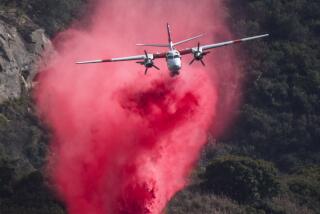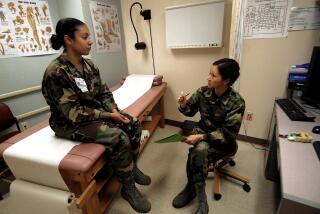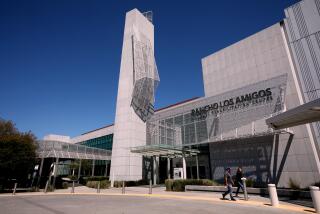Nurses Have Replaced Doctors on All San Diego Life Flight Trips
- Share via
The physicians who have played a prominent role in San Diego County’s Life Flight system since its inception in 1980 have been gradually shifted off the emergency medical helicopters and none are serving on them as of today.
Officials at UC San Diego Medical Center, which operates Life Flight, said recent increases in demand for emergency services at the hospital have made it impossible to assign scarce emergency-room doctors to serve on the one helicopter that still carried them.
The doctors are being replaced by flight nurses, who officials say are trained to conduct nearly all the procedures the physicians were called upon to perform. They will be accompanied by paramedics or by other flight nurses.
The change comes at a time of nationwide discussion within the emergency medical community over the value of having doctors on “aeromedical” flights. Research published in recent months suggests that they can make a difference--but in a limited number of cases.
Nurses Can Be Trained
Some researchers suggest that the doctors’ training gives them a certain “judgment” that nurses or paramedics may or may not be able to acquire. But they say nurses can be trained to perform nearly any medical procedure that is likely to be needed.
Experts say the decision whether to use doctors is often influenced by other factors, including cost, physician availability, community expectations and the peculiar mission of an individual system.
“There’s a business decision as well as a patient-care decision,” said Dr. Henry Bock, medical adviser to ASHBEAMS, a San Diego-based group representing emergency medical providers nationwide. “There’s no one best way of doing these things.”
Currently, about 15% of the 165 medical helicopter systems in the country are staffed by doctors, said Nina Merrill, executive director of ASHBEAMS. She said most of those are systems based in large teaching hospitals.
Marcia Katz, chief flight nurse for Stanford Life Flight in Palo Alto, said there could be a trend away from doctor staffing. She said there may be “a safety concern that makes physicians look a little differently at transport.”
Crash Raised Questions
Although the crash of a Life Flight helicopter in San Diego last year raised questions about doctors’ willingness to continue riding the flights, Dr. William Baxt, Life Flight medical director, said doctors enjoyed the “challenge” and will miss it.
However, others said doctors, at least elsewhere, were not always comfortable with the obligation.
“Marcus Welby was never on a helicopter,” said Merrill.
Life Flight officials said they moved in May to phase out doctors from Life Flight 1, the helicopter based at UCSD Medical Center. Life Flight 2, based at Palomar airport, has had no physicians since 1984. Life Flight 3, which works only on weekends, is staffed by a nurse.
Until recently, Life Flight 1 had been staffed by physicians from the UCSD emergency room. But over the last four years, the annual emergency-room “census” has risen from 30,000 to 50,000 patients, hospital officials said.
“It was more cost-effective to put (the doctors) there than on the helicopter,” said Baxt. He said a doctor might treat no more than four patients per Life Flight shift, compared to 30 on an emergency-room shift.
Baxt said he was confident that, with proper flight-nurse training, there would be no significant difference in patient care on Life Flight. He said the system is also testing the efficacy of having two flight nurses, rather than a nurse and a paramedic, on some flights.
“Actually, there is basically nothing that our nurses can’t do that the physicians were doing on the flights,” said Marti Bennett, chief flight nurse for the system.
Bennett said the flight nurses are qualified to perform such procedures as running a tube down a patient’s trachea into the lungs to enable him to breathe, cutting open the chest wall and inserting a tube to re-inflate a lung, and administering some medications.
Flight nurses may also administer medications that paramedics and other nurses can’t.
Orientation Required
Bennett said flight nurses are required to take a six-week orientation to learn the new skills required for the job, in addition to at least eight hours of classes a month after that to maintain their skills.
“I think if you’re willing to make the commitment to give the nursing staff the training, advanced skills and knowledge that they need to function as the physicians do in the field, you don’t need the physicians on the flight,” Bennett said.
Most of the physicians stopped riding the Life Flight helicopters in May. However, three junior faculty doctors continued to serve on the flights until Wednesday, Baxt said.
Coincidentally, Baxt is the co-author of a recent study of Life Flight cases that concluded that deaths of patients treated by flight nurse-physician teams were 35% lower than predicted and significantly lower than that of patients treated by nurse-paramedic teams.
The study, published last month in the Journal of the American Medical Assn., was based on 600 patients with so-called blunt trauma transported by Life Flight medical helicopters in San Diego County.
On Wednesday, Baxt pointed out that, while the difference in patient outcome was statistically significant, the study covered a relatively small number of patients. He said only one in 50 patients appeared to have been affected by the difference in treatment.
Baxt added that he believed that the differences would disappear with the help of nurse training. He said he also thought that putting two flight nurses on the helicopter, rather than a nurse and a paramedic, could also improve the outcome statistics.
Another recent study conducted by the Metro Life Flight program at Cleveland Metropolitan General Hospital in Ohio concluded that physicians were “necessary” on 25% of the 395 flights studied--in order to handle a change in diagnosis or medication, or for an emergency.
In addition, a doctor could have been needed in 35% of the cases. For example, if the patient were on a support system, a doctor could have been needed if an emergency arose, said Dr. Norman Snow, a co-author of the study and medical director of the system.
Snow and others pointed out Wednesday that physicians may be more useful in some systems than in others. They said the need for doctors may be less in systems, like San Diego’s, that cater primarily to “trauma scene runs.”
By contrast, they said there may be more demand for doctors in systems that do a lot of moving of critical patients from one hospital to another for more sophisticated care. One such system is Stanford Life Flight, based at Stanford Medical Center in Palo Alto.
“It’s a philosophy of our hospital here that we want to put a physician on every transport because the nature of our flights is somewhat different than San Diego,” said Katz, Stanford’s chief flight nurse. She said her system does a lot of “inter-hospital transport” handling “very, very critical” patients.
Katz said the decision is also based on educational goals.
“Philosophically, Stanford wants physicians to integrate that into their training,” said Katz, who said the doctors who fly are completing their training. “It’s a key piece of training for any physician who works in the (emergency) department.”
Luanne Underwood, chief flight nurse for the UCLA MedStar system, said her system uses doctors both to have “that extra bit of clinical judgment” and “from a marketing standpoint, in all honesty.”
Underwood said the presence of doctors on the MedStar flights “makes us a little bit more marketable.”
More to Read
Sign up for Essential California
The most important California stories and recommendations in your inbox every morning.
You may occasionally receive promotional content from the Los Angeles Times.










